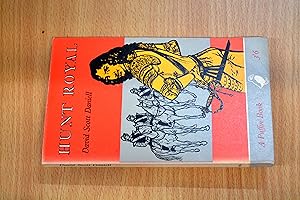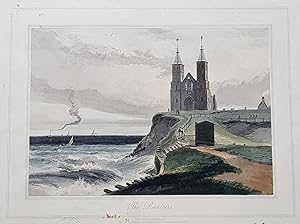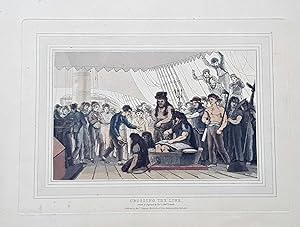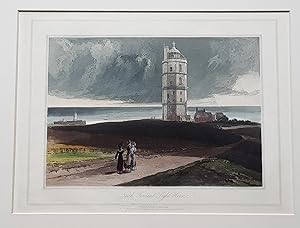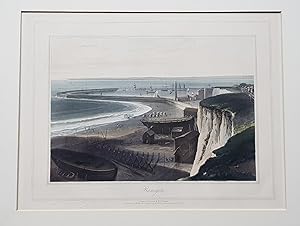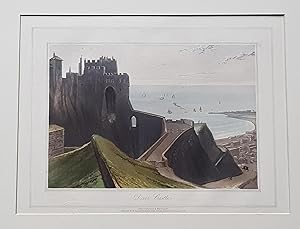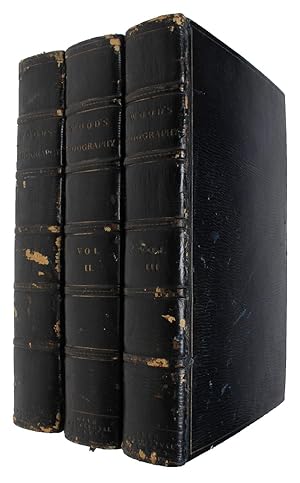Illustrated William Daniell (9 results)
Product Type
- All Product Types
- Books (4)
- Magazines & Periodicals
- Comics
- Sheet Music
- Art, Prints & Posters (5)
- Photographs
- Maps
-
Manuscripts &
Paper Collectibles
Condition
- All Conditions
- New
- Used
Binding
Collectible Attributes
- First Edition (8)
- Signed (1)
- Dust Jacket
- Seller-Supplied Images (7)
- Not Printed On Demand
Seller Location
Seller Rating
-
Hunt Royal (Puffin Books PS 174)
Published by Penguin Puffin, Harmondsworth, 1962
Seller: Alexander's Books, Royal Leamington Spa, United Kingdom
Book First Edition
Soft cover. Condition: Very Good. No Jacket. William Stobbs (illustrator). 1st Edition. First edition first printing as Penguin Puffin paperback. 160 pp., illustrated. No inscriptions Very Good condition. Nice copy.
-
Hunt Royal (A Puffin Book)
Published by Penguin Books, 1962
Seller: HALCYON BOOKS, LONDON, United Kingdom
First Edition
Paperback. Condition: Very Good. First Edition. A clean, tight copy. First penguin edition. Black and white illustrations throughout by Williams Stobbs. ALL ITEMS ARE DISPATCHED FROM THE UK WITHIN 48 HOURS ( BOOKS ORDERED OVER THE WEEKEND DISPATCHED ON MONDAY) ALL OVERSEAS ORDERS SENT BY TRACKABLE AIR MAIL. IF YOU ARE LOCATED OUTSIDE THE UK PLEASE ASK US FOR A POSTAGE QUOTE FOR MULTI VOLUME SETS BEFORE ORDERING.
-
The Reculvers. Drawn and Engraved by William Daniell.
Published by London: Published by W Daniell Cleveland Street Fitzroy Square, 1823
Seller: Geoffrey Jackson, Royal Wootton Bassett, WILTS, United Kingdom
Art / Print / Poster First Edition
No Binding. Condition: Very Good. 1st Edition. A fine original aquatint and etching on paper illustrating a view of the Reculvers, the imposing twin towers of the medieval church at Reculver which dominate the skyline of Herne Bay, acting as a navigation marker for ships at sea. Illustration produced for 'A Voyage Around Great Britain', a series of 308 aquatints published in eight volumes between 1814-1825, described by R.V. Tooley as 'the most important colour plate book on British Topography'. Printed on J. Whatman watermarked paper with fine original hand colouring. Image size approx. 9" x 11" (23cm x 28cm) with margins. A generally VG bright impression with a few light marks which has excellent original hand colouring, with a small lightly embossed stamp to lower margin. William Daniell, (1769-1837) - A Voyage Round Great Britain' : In early 1813, Daniell conceived of the ambitious plan to travel around the entire coastline of Britain while producing an illustrated work of the voyage. ,In 1814, artist engraver William Daniell set out to record the people, places, towns and villages around Britain's coastline. Eleven years later he completed his magnum opus having travelled from Land's End to John 0'Groats via the west coast, then back to Land's End via the east.The result was a collection of 308 aquatint engravings, the last great artist's voyage before photography was invented. images all 9" x 11", William Daniell, an engraver and painter, belonged to a family of English artists. He was raised by his uncle, Thomas Daniell, a painter and engraver, lived with him in India from 1784-94, and worked with him on publications based on his travels. In 1795 he settled in London, where he remained for the rest of his life. He collaborated with Thomas on A Voyage Round Great Britain (1814-25). Daniell was a member of the Royal Academy and exhibited there from 1795 to 1838 This series was published in 8 volumes during the period 1814 to 1825. The journey was initially started in 1813 and was a joint project with William Daniell producing the drawings and William Ayton the text. This partnership lasted for the first two volumes, thereafter Daniell produced the text as well. The latter text relates to the plates and is relatively pedestrian, whereas Ayton used the voyage for his own agenda and sociological interests, his text is only loosely related to the plates and concentrates on the manners and customs of people he met.308 handcoloured aquatints. Thomas Sutton in The Daniells Artists and Travellers outlines the journey as follows: . . "During the summer of 1813 Ayton and Daniell surveyed the coast from Land's End up to Holyhead, where the first year's voyage closed near the middle of October (plates 1-26). The following year their journeys re commenced at Holyhead, at the beginning of August, and proceeded as far as Creetown or Dunsky Castle in Kircudbright. This at any rate, was the limit of Ayton's tour (plates 27-56). Daniell started off alone from Wigtown, early in the summer and finished his survey of the entire coast of Scotland, as far as Dundee, which he reached in October. This very lengthy tour was rendered possible by an exceptionally fine spell of weather (plates 57-195). Six years elapsed before Daniell commenced the further prosecution of his journey. Arriving at St. Andrews on August 4th, 1821, he surveyed the remaining portion of the Scottish coast, and the east coast of England as far as Southend, which he reached towards the end of September (plates 196-224). The following year he left Sheerness on July 28th, and explored the south coast as far as Torquay, whence he returned to London on September 27th (plates 225-277). The concluding tour, a comparatively short one, commenced from Torquay on Thursday, August 21st, 1823, and embraced the final portion of the south coast to Land's end, which was reached for the second time on September 14th (plates 278-308).
-
Crossing the Line. (dressing up on crossing the Equator), from 'A Picturesque Journey to India, by the Way of China', 1810. Drawn and Engraved by William Daniell.
Published by London: Longman Hurst Rees & Orme, 1810
Seller: Geoffrey Jackson, Royal Wootton Bassett, WILTS, United Kingdom
Art / Print / Poster First Edition
No Binding. Condition: Very Good. 1st Edition. A fine original aquatint and etching on paper illustrating Crossing the Line originally published in ' A Picturesque Voyage to India by the Way of China' by Longman, Hurst, Rees, and Orme, in 1810. It records the journey from England, with scenes taken at Madeira, the Cape of Good Hope, Java, Macao, Canton, the Straits of Malacca, and Calcutta. The work also contains images of Malays and Chinese. Plate size approx. 7.5 " x 9.5" (19cm x 25cm) with margins. A generally VG bright impression with a few light marks. The line-crossing ceremony is an initiation rite that commemorates a person's first crossing of the Equator. The tradition may have originated with ceremonies when passing headlands, and become a "folly" sanctioned as a boost to morale, or have been created as a test for seasoned sailors to ensure their new shipmates were capable of handling long rough times at sea. Equator-crossing ceremonies, typically featuring King Neptune, are common in the navy and are also sometimes carried out for passengers' entertainment on civilian ocean liners and cruise ships. They are also performed in the merchant navy and aboard sail training ships. William Daniell RA (1769 1837) was an English landscape and marine painter, and printmaker, notable for his work in aquatint. He travelled extensively in India in the company of his uncle Thomas Daniell, with whom he collaborated on one of the finest illustrated works of the period Oriental Scenery. He later travelled around the coastline of Britain to paint watercolours for the equally ambitious book A Voyage Round Great Britain. His work was exhibited at the Royal Academy and the British Institution and he became a Royal Academician in 1822. Originally issued in ten parts, "the aquatints of India by Thomas and William Daniell have been continuously popular ever since their publication between 1795 and 1810 A Picturesque Voyage consisted of 50 aquatints depicting the places visited by the artists on their various journeys to and from China and to India. Five views show their approach to Calcutta and the city itself. The publication of these aquatints had been a mammoth task. The two artists prepared almost all the plates themselves. [William Daniell came to be regarded as] one of the greatest aquatinters of the 19th century The Daniells Indian aquatints soon made an impact on the British public and on British culture at a number of different levels" (Early Views of India, 223-225). "One of a series of books that are surely among the most beautiful things ever made" (IPEX Exhibition of English Colour Plate Books).
-
North Foreland Lighthouse. Drawn and Engraved by William Daniell.
Published by London: Published by W Daniell Cleveland Street Fitzroy Square, 1823
Seller: Geoffrey Jackson, Royal Wootton Bassett, WILTS, United Kingdom
Art / Print / Poster First Edition
No Binding. Condition: Near Fine. 1st Edition. A fine original aquatint and etching on paper illustrating a view of North Foreland lighthouse and other buildings overlooking the sea, with dark cloudy sky behind; two elegantly dressed women, a man and a dog standing on a road in foreground at centre left. Illustration produced for 'A Voyage Around Great Britain', a series of 308 aquatints published in eight volumes between 1814-1825, described by R.V. Tooley as 'the most important colour plate book on British Topography'. Printed on J. Whatman watermarked paper with fine original hand colouring. Image size approx. 9" x 11" (23cm x 28cm), professionally mounted in acid-free, conservation cut-out mount ready for framing. A generally fine bright clean impression which has excellent original hand colouring, with a small lightly embossed stamp to lower margin. William Daniell, (1769-1837) - A Voyage Round Great Britain' : In early 1813, Daniell conceived of the ambitious plan to travel around the entire coastline of Britain while producing an illustrated work of the voyage. ,In 1814, artist engraver William Daniell set out to record the people, places, towns and villages around Britain's coastline. Eleven years later he completed his magnum opus having travelled from Land's End to John 0'Groats via the west coast, then back to Land's End via the east.The result was a collection of 308 aquatint engravings, the last great artist's voyage before photography was invented. images all 9" x 11", William Daniell, an engraver and painter, belonged to a family of English artists. He was raised by his uncle, Thomas Daniell, a painter and engraver, lived with him in India from 1784-94, and worked with him on publications based on his travels. In 1795 he settled in London, where he remained for the rest of his life. He collaborated with Thomas on A Voyage Round Great Britain (1814-25). Daniell was a member of the Royal Academy and exhibited there from 1795 to 1838 This series was published in 8 volumes during the period 1814 to 1825. The journey was initially started in 1813 and was a joint project with William Daniell producing the drawings and William Ayton the text. This partnership lasted for the first two volumes, thereafter Daniell produced the text as well. The latter text relates to the plates and is relatively pedestrian, whereas Ayton used the voyage for his own agenda and sociological interests, his text is only loosely related to the plates and concentrates on the manners and customs of people he met.308 handcoloured aquatints. Thomas Sutton in The Daniells Artists and Travellers outlines the journey as follows: . . "During the summer of 1813 Ayton and Daniell surveyed the coast from Land's End up to Holyhead, where the first year's voyage closed near the middle of October (plates 1-26). The following year their journeys re commenced at Holyhead, at the beginning of August, and proceeded as far as Creetown or Dunsky Castle in Kircudbright. This at any rate, was the limit of Ayton's tour (plates 27-56). Daniell started off alone from Wigtown, early in the summer and finished his survey of the entire coast of Scotland, as far as Dundee, which he reached in October. This very lengthy tour was rendered possible by an exceptionally fine spell of weather (plates 57-195). Six years elapsed before Daniell commenced the further prosecution of his journey. Arriving at St. Andrews on August 4th, 1821, he surveyed the remaining portion of the Scottish coast, and the east coast of England as far as Southend, which he reached towards the end of September (plates 196-224). The following year he left Sheerness on July 28th, and explored the south coast as far as Torquay, whence he returned to London on September 27th (plates 225-277). The concluding tour, a comparatively short one, commenced from Torquay on Thursday, August 21st, 1823, and embraced the final portion of the south coast to Land's end, which was reached for the second time on September 14th (plates 278-308).
-
Ramsgate, Kent. Drawn and Engraved by William Daniell.
Published by London: Published by W Daniell Cleveland Street Fitzroy Square, 1823
Seller: Geoffrey Jackson, Royal Wootton Bassett, WILTS, United Kingdom
Art / Print / Poster First Edition
No Binding. Condition: Near Fine. 1st Edition. A fine original aquatint and etching on paper illustrating a fine coastal view at Ramsgate from a cliff plateau, crowded with figures behind a wooden fence at right; dockyard with boats below in fogreground at left, and the harbour beyond. Illustration produced for 'A Voyage Around Great Britain', a series of 308 aquatints published in eight volumes between 1814-1825, described by R.V. Tooley as 'the most important colour plate book on British Topography'. Printed on J. Whatman watermarked paper with fine original hand colouring. Image size approx. 9" x 11" (23cm x 28cm), professionally mounted in acid-free, conservation cut-out mount ready for framing. A generally fine bright clean impression which has excellent original hand colouring, with a small lightly embossed stamp to lower margin. William Daniell, (1769-1837) - A Voyage Round Great Britain' : In early 1813, Daniell conceived of the ambitious plan to travel around the entire coastline of Britain while producing an illustrated work of the voyage. ,In 1814, artist engraver William Daniell set out to record the people, places, towns and villages around Britain's coastline. Eleven years later he completed his magnum opus having travelled from Land's End to John 0'Groats via the west coast, then back to Land's End via the east.The result was a collection of 308 aquatint engravings, the last great artist's voyage before photography was invented. images all 9" x 11", William Daniell, an engraver and painter, belonged to a family of English artists. He was raised by his uncle, Thomas Daniell, a painter and engraver, lived with him in India from 1784-94, and worked with him on publications based on his travels. In 1795 he settled in London, where he remained for the rest of his life. He collaborated with Thomas on A Voyage Round Great Britain (1814-25). Daniell was a member of the Royal Academy and exhibited there from 1795 to 1838 This series was published in 8 volumes during the period 1814 to 1825. The journey was initially started in 1813 and was a joint project with William Daniell producing the drawings and William Ayton the text. This partnership lasted for the first two volumes, thereafter Daniell produced the text as well. The latter text relates to the plates and is relatively pedestrian, whereas Ayton used the voyage for his own agenda and sociological interests, his text is only loosely related to the plates and concentrates on the manners and customs of people he met.308 handcoloured aquatints. Thomas Sutton in The Daniells Artists and Travellers outlines the journey as follows: . . "During the summer of 1813 Ayton and Daniell surveyed the coast from Land's End up to Holyhead, where the first year's voyage closed near the middle of October (plates 1-26). The following year their journeys re commenced at Holyhead, at the beginning of August, and proceeded as far as Creetown or Dunsky Castle in Kircudbright. This at any rate, was the limit of Ayton's tour (plates 27-56). Daniell started off alone from Wigtown, early in the summer and finished his survey of the entire coast of Scotland, as far as Dundee, which he reached in October. This very lengthy tour was rendered possible by an exceptionally fine spell of weather (plates 57-195). Six years elapsed before Daniell commenced the further prosecution of his journey. Arriving at St. Andrews on August 4th, 1821, he surveyed the remaining portion of the Scottish coast, and the east coast of England as far as Southend, which he reached towards the end of September (plates 196-224). The following year he left Sheerness on July 28th, and explored the south coast as far as Torquay, whence he returned to London on September 27th (plates 225-277). The concluding tour, a comparatively short one, commenced from Torquay on Thursday, August 21st, 1823, and embraced the final portion of the south coast to Land's end, which was reached for the second time on September 14th (plates 278-308).
-
Dover Castle, Kent. Drawn and Engraved by William Daniell.
Published by London: Published by W Daniell Cleveland Street Fitzroy Square, 1823
Seller: Geoffrey Jackson, Royal Wootton Bassett, WILTS, United Kingdom
Art / Print / Poster First Edition
No Binding. Condition: Near Fine. 1st Edition. A fine original aquatint and etching on paper illustrating a fine view of Dover Castle looking at the very large fortification of the Constable's tower from the east, looking to the town and beach below. Illustration produced for 'A Voyage Around Great Britain', a series of 308 aquatints published in eight volumes between 1814-1825, described by R.V. Tooley as 'the most important colour plate book on British Topography'. Printed on J. Whatman watermarked paper with fine original hand colouring. Image size approx. 9" x 11" (23cm x 28cm), professionally mounted in acid-free, conservation cut-out mount ready for framing. A generally fine bright clean impression which has excellent original hand colouring, with a small lightly embossed stamp to lower margin. William Daniell,(1769-1837) - ' A Voyage Round Great Britain' : In early 1813, Daniell conceived of the ambitious plan to travel around the entire coastline of Britain while producing an illustrated work of the voyage. In 1814, artist engraver William Daniell set out to record the people, places, towns and villages around Britain's coastline. Eleven years later he completed his magnum opus having travelled from Land's End to John 0'Groats via the west coast, then back to Land's End via the east.The result was a collection of 308 aquatint engravings, the last great artist's voyage before photography was invented. images all 9" x 11", William Daniell, an engraver and painter, belonged to a family of English artists. He was raised by his uncle, Thomas Daniell, a painter and engraver, lived with him in India from 1784-94, and worked with him on publications based on his travels. In 1795 he settled in London, where he remained for the rest of his life. He collaborated with Thomas on A Voyage Round Great Britain (1814-25). Daniell was a member of the Royal Academy and exhibited there from 1795 to 1838 This series was published in 8 volumes during the period 1814 to 1825. The journey was initially started in 1813 and was a joint project with William Daniell producing the drawings and William Ayton the text. This partnership lasted for the first two volumes, thereafter Daniell produced the text as well. The latter text relates to the plates and is relatively pedestrian, whereas Ayton used the voyage for his own agenda and sociological interests, his text is only loosely related to the plates and concentrates on the manners and customs of people he met.308 handcoloured aquatints. Thomas Sutton in The Daniells Artists and Travellers outlines the journey as follows: . . "During the summer of 1813 Ayton and Daniell surveyed the coast from Land's End up to Holyhead, where the first year's voyage closed near the middle of October (plates 1-26). The following year their journeys re commenced at Holyhead, at the beginning of August, and proceeded as far as Creetown or Dunsky Castle in Kircudbright. This at any rate, was the limit of Ayton's tour (plates 27-56). Daniell started off alone from Wigtown, early in the summer and finished his survey of the entire coast of Scotland, as far as Dundee, which he reached in October. This very lengthy tour was rendered possible by an exceptionally fine spell of weather (plates 57-195). Six years elapsed before Daniell commenced the further prosecution of his journey. Arriving at St. Andrews on August 4th, 1821, he surveyed the remaining portion of the Scottish coast, and the east coast of England as far as Southend, which he reached towards the end of September (plates 196-224). The following year he left Sheerness on July 28th, and explored the south coast as far as Torquay, whence he returned to London on September 27th (plates 225-277). The concluding tour, a comparatively short one, commenced from Torquay on Thursday, August 21st, 1823, and embraced the final portion of the south coast to Land's end, which was reached for the second time on September 14th (plates 278-308).
-
Romantic and Picturesque Scenery of the Isle of Wight: The Journal of a Gentleman (Signed Limited Edition)
Published by Cross Publishing, Chale, 2008
Seller: Wheeler's Bookshop, Midhurst, West Sussex, United Kingdom
First Edition Signed
Hardcover. First Edition. Oblong 4to. Attractive maroon half-leather (leather spine, corners and title-piece) with marbled boards. 160 pp. AEG. Superb collection of early 19th Century topographical paintings and illustrations depicting many areas of the Isle of Wight, superbly reproduced as colour plates. Fascinating views of the island still in its untamed state, and some long-vanished landmarks. Limited Edition (numbered 481 of only 650 printed). Pictorial plate, signed and hand-numbred by the author at ffep, as issued. With subscribers-list sheet. Near as-new condition with just lightest rubbing to lower rear cover. NEAR FINE.
-
London, Cadell and Davies, 1897. Royal 8vo. Bound in 3 fine contemp. full longgrained morocco. Raised bands. Inside and outside gilt borders. All edges gilt. A few scratches to spines. XIX,VIII,572VIII,618VII,612 pp. and 110 !! beautifull engraved aquatint plates by William Daniell. Internally fine and clean, printed on good paper (wove paper). An exceptional copy with 50 additional plates as it has 110 plates instead of 60, a number recorded recorded in all listed library copies and in the copies for sale.Casey A. Wood, p. 635. - Nissen, 4460 (only calling for 60 plates).



